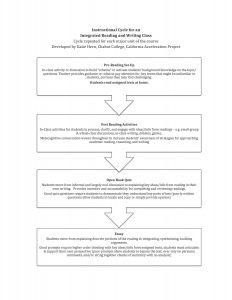Pre-reading set-up
In-class activity or discussion to build “schema” or activate students’ background knowledge on the topic/ questions. Teacher provides guidance (what to pay attention for, key terms that might be unfamiliar to students, portions they may find challenging). Students read assigned texts at home.
Post Reading Activities
In-Class activities for students to process, clarify, and engage with ideas/info from readings – e.g. small-group & whole-class discussions, in-class writing, debates, games. Metacognitive conversation woven throughout to increase students’ awareness of strategies for approaching academic reading, reasoning, and writing.
Open Book Quiz
Students move from informal and largely oral discussion to explaining key ideas/info from reading in their own writing. Provides incentive and accountability for completing and reviewing readings. Good quiz questions require students to demonstrate they understand key parts of text (poorly written questions allow students to locate and copy or simply provide opinion)
Essay/Main assignment
Students move from explaining discrete portions of the reading to integrating, synthesizing, building arguments. Good prompts require higher order thinking with key ideas/info from assigned texts, students must articulate & support their own perspective (poor prompts allow students to bypass the text, over-rely on personal comments, and/or string together chunks of summary with no analysis)
Attribution: This is a publicly shared document, redistributed on this site under fair use. “Instructional Cycle for Integrated Reading and Writing Classes,” by Katie Hern, California Accelerated Project (2016).



